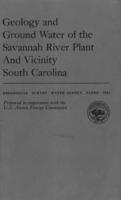Geology and ground water of the Savannah River Plant and vicinity, South Carolina
Links
- Document: Report (pdf)
- Plates:
- NGMDB Index Page: National Geologic Map Database Index Page
- Download citation as: RIS | Dublin Core
Abstract
The area described in this report covers approximately 2,600 square miles in west-central South Carolina and includes the site of the Savannah River Plant, a major production facility of the U.S. Atomic Energy Commission. The climate, surface drainage, and land forms of the study area are typical of the southern part of the Atlantic Coastal Plain. Precipitation is normally abundant and fairly evenly distributed throughout the year, and the mean annual temperature is moderately warm (64?F). The major streams that drain the area (the Savannah, Salkehatchie, and Edisto Rivers) have low gradients and flow in a southeasterly direction toward the Atlantic Ocean. Surface features of the area include narrow, flat-bottomed, steep-sided valleys and broad gently rolling interfluvial areas. Those parts of the Coastal Plain included within the report area can be subdivided into the Aiken Plateau, the Congaree Sandhills, and the Coastal Terraces. The area is underlain by a sequence of unconsolidated and partly consolidated sediments of Late Cretaceous, Tertiary, and Quaternary age. The unconsolidated sediments were deposited unconformably on a basement of igneous and metamorphic rocks of Precambrian and Paleozoic age and sedimentary rocks of Triassic age. The basement rocks are similar to the granite-diorite complex of the Charlotte Belt, the metamorphosed rocks of the Carolina Slate Belt, and the consolidated sediments of the Newark Group. The unconsolidated sediments strike about N. 60 ? E. and dip 6-20 feet per mile to the southeast. They form a wedge-shaped mass that increases in thickness toward the southeast to slightly more than 1,200 feet in the vicinity of Allendale, S.C., on the southeast or downdip side of the study area. The oldest or lowermost unconsolidated sedimentary unit, the Tuscaloosa Formation of Late Cretaceous age, is overlain in the subsurface by beds that are also probably Late Cretaceous in age and that herein are named the Ellenton Formation. The Upper Cretaceous deposits are, in turn, overlain by the, McBean Formation and the Congaree(?) Formation of middle Eocene age, the Barnwell Formation of late Eocene age, the Hawthorn Formation of early and middle Miocene age, and by fluvial and marine(?) terrace deposits of Pliocene(?), Pleistocene, and Recent age. In the mapped area, the Congaree(?) Formation includes undifferentiated rocks (mostly Congaree and Barnwell Formations and some Mcbean outliers). (See map explanation.) Structurally, the Upper Cretaceous sediments are overlapped to the northwest by Tertiary deposits. A preliminary geologic map of the general area is included in the report. The principal aquifer in the area is composed of the beds of medium to coarse sand and gravel contained in the Tuscaloosa and Ellenton Formations. Subordinate aquifers include deposits of sand and limestone of Tertiary and Quaternary age. The ground water in the principal aquifer occurs under water-table conditions in the outcrop area of the Tuscaloosa Formation in the northern and western parts of the study area, but it is under artesian pressure downdip in the southern and eastern parts of the study area. Contours drawn on the piezometric surface of the water in the principal aquifer indicate that water is recharged to the aquifer mainly by leakage through the overlying Tertiary formations. Likewise, the piezometric contours show that the outcrop area of the Tuscaloosa Formation functions chiefly as an area of discharge. Doubtless, water is also discharged from the aquifer by moving downdip to areas near the coast where the prevailing hydraulic gradient may favor the upward leakage of water through the upper confining beds. The hydraulic properties of the principal aquifer were determined by a series of pumping tests. The results indicate that the aquifer is highly productive and could supply 15 million gallons per day in the vicinity of the Savannah River Plant without exceeding the available drawdown.
Study Area
| Publication type | Report |
|---|---|
| Publication Subtype | USGS Numbered Series |
| Title | Geology and ground water of the Savannah River Plant and vicinity, South Carolina |
| Series title | Water Supply Paper |
| Series number | 1841 |
| DOI | 10.3133/wsp1841 |
| Year Published | 1967 |
| Language | English |
| Publisher | U.S. Geological Survey |
| Contributing office(s) | South Atlantic Water Science Center |
| Description | Report: iv, 113 p.; 6 Plates: 33.00 × 29.50 inches or smaller |
| Country | United States |
| State | South Carolina |
| Other Geospatial | Savannah River Plant |
| Scale | 125000 |


